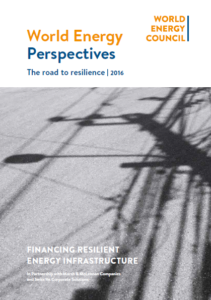-
Road to Resilience Report: energy sector needs to manage growing threats of extreme weather, energy-water-food nexus and cyber-attacks
-
23rd World Energy Congress in less than a month will see world energy leaders seek viable solutions
The findings come just a month prior to the 23rd World Energy Congress in Istanbul where high-level discussions exploring these energy resilience issues will be led by Satoru Katsuno, President and Chairman of Chubu Electric Power Company, and Juerg Trueb Managing Director, Environmental and Commodity Markets, Swiss Re Corporate Solutions. They will look at the risks to the industry and, crucially, what policy solutions are needed to adjust to the ‘new normal’.
-
Energy is the second-most water intensive industry after agriculture, with 98% of power supply dependent on the availability of water
-
Extreme weather events have increased by a factor four over the past thirty years. Frequent and severe weather events can affect energy infrastructure across the value chain, and often lead to higher demand
-
The sophistication and frequency of cyber-attacks is growing, and continues to keep energy leaders in Europe and North America awake at night. By 2018, the oil and gas industries could be spending US$1.87 billion each year on cyber security
Christoph Frei, Secretary General, World Energy Council, said:
“The different risks to resilience have very distinct meaning and priorities in different regions. Yet the imperative to cope with these risks is a powerful catalyst for innovation with transformative global impact: innovation in technology, system design and management, cross-country and -value chain cooperation, the required policies and, last but not least, financing concepts. Securing the future investments to expand and transform the sector is the critical challenge ahead.”
Jeroen van der Veer, Executive Chair, Road to Resilience, and former CEO of Royal Dutch Shell, said:
Over the two years the series of reports examined the evolution of these risks and their impact on energy infrastructure, and identified measures required to increase resilience of, and improve the financing conditions for, investments in energy infrastructure that is able to cope with these new challenges.
Key recommendations within the Road to Resilience: Financing resilient energy infrastructure includes:
-
Smarter design of energy systems: energy systems must be smarter, not just stronger, to withstand diverse emerging risks and be more resilient.
-
Encourage diversity within the energy sector and related industries: diversity increases flexibility and helps to avoid and mitigate the implications of potential threats.
-
Increased private finance infrastructure: resilience is vital in attracting a more diverse group of investors, including institutional investors, to the energy sector
-
Improved regulation and market guidance: policymakers must develop clear, transparent, predictable legal frameworks to ensure resilience and stimulate finance.
The road to resilience series features three deep dive reports:
-
Managing cyber risks







